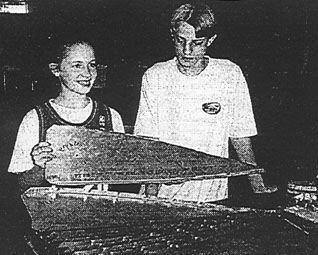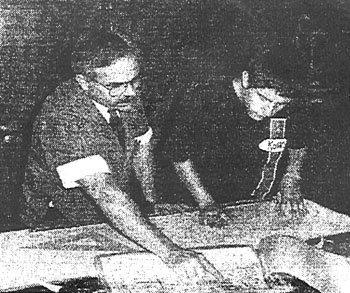
Zenith Aircraft Co.
ZENITH AIRCRAFT AT WORK AROUND THE WORLD
Project Schoolflight: Junior High Students Build Aircraft with EAA Mentors
- Visit the Project SchoolFlight website: http://www.cksd.wednet.edu/CKJH/airplane/
(This is an excellent site on this project)
- From "Project Schoolflight Update" Volume 2, 07 January 1998
Project Schoolflight at CK Jr. High keeps getting more exciting. On the last project day before the holiday break construction teams riveted the main and nose ribs to both wing spars. Suddenly we have an airplane, or at least parts that really look like one. The next steps will be to install the rear channels, the various fittings, construct the auxiliary fuel tanks, and skin the wings.
A building team of the size we have allows us to construct many parts at the same time. While the wings are being built, other teams are fabricating individual pieces for the fuselage, flaperons, slats, and elevators. Since the CH-701 is made of many individual aluminum pieces, builders may finish and store fittings, angles, doors, skins, etc. to be assembled later. Mr. Smith is tracking part completion and assigning new parts to be built based on construction sequence and student abilities.
We have had 27 building sessions since 11 September. There have been approximately 800 hours of student construction time and 320 hours of mentor assistance. Regular attendance is generally 15-20 students per session with 4-11 mentors assisting.
Students are learning a variety of skills. The first thing everyone must master is working to a specific tolerance. The CH-701 is a simple and reasonably forgiving design but any inaccuracies can multiply. The entire team understands that aviation is an area with stringent demands. We have a sign posted reading: The laws of aerodynamics are unforgiving and the ground is hard. Each piece of the aircraft is being made within 1 mm of the design measurements. Students are meeting this requirement with little trouble. Of the 200 pieces constructed to date, fewer than 10 have had to be remade and 5 of those were the result of inadequate forming blocks.
The second group of skills to master is metalwork with hand tools; cutting with snips, flatfiling, drawfiling, deburring, and hand bending. Each of the pieces that comprise the CH-701 starts as part of a large flat sheet of aluminum. Students study the plans, make a full-sized paper template, choose the correct aluminum sheet, mark out the piece, check the measurements, cut out the piece, file to shape, deburr and smooth the edges, and drill any necessary holes.
A third group of skills includes using stationary metalworking tools. Before this project, few of the students and only some of the mentors had used stationary shears, bending breaks, drill presses, and stationary sanders. If necessity is the mother of invention it is also the impetus to learning new skills.
The most interesting new skill and the one almost unique to aircraft construction is riveting. The CH-701 has two kinds of rivets; formed rivets and pop rivets. The formed rivets are small, blunt, brad-like metal fasteners. They are inserted into a hole through two or more thicknesses of aluminum and an air-driven rivet gun pounds the small end of the rivet into a flat shape, holding the aluminum together. The pop rivets are like those sold in hardware stores but manufactured to aircraft standards. The majority of the rivets in the airplane will be the pop rivets but the first to be installed were the driven rivets.
The wing spars are made of a long flat piece with two angle section, one on the top and one on the bottom. The angle sections are attached to the flat piece with driven rivets every inch.
Each rivet requires a driver handling the rivet gun and the bucker with a bucking bar to drive the rivet against. We formed several of these teams and under the watchful eyes of the mentors, students riveted the wing spars together.
Our Web Site: As of January 1st we have a preliminary web site constructed but not yet up and running. We need to finalize the design and content, receive approval, and have it loaded on the server. This should happen by mid-January. When complete, the site will have news of our progress, information and photos of the CH-701 aircraft, links to other aviation, aircraft construction, and sport flying websites, and profiles of the Chapter 406 mentors.
Right now news of our project can be seen on the Zenith site. Zenith Aircraft is the company that designed the CH-70 1. They have news of people building their airplanes and can be found at www.zenithair.com
Integrations: The most delightful part of the project are all the unexpected opportunities for other students to take part. Design classes in the Art Department have been working on paint schemes for the aircraft, the Music Department is composing a triumphal processional for the gala roll out ceremonies, the Computer Department is constructing the aircraft in the CAD system, and next to become involved is the French Department! We have found the web site of a high school in Remiremont, France that is building an airplane. We are translating the information found on their site, and have proposed a correspondence.
Flight: As part of the community involvement program of EAA Chapter 406, the members are offering 'Young Eagle' flights to the builders of the CKJH CH-701. The EAA has set a goal of giving one million airplane rides to youth between the ages of 8 and 16 by the year 2003. They are a third of the way to the goal. Clark Coulter, the chapter's Young Eagle Coordinator has offered to put builders in touch with a local pilot for a ride. The winter weather will slow things down a bit as it becomes more difficult to find clear, dry days, but when the opportunity presents itself, airplanes will fly!
Robert Eskridge, a chapter member and Flight Instructor has an even better offer! He will give a few of the most motivated students flight instruction during their ride. The EAA Chapter will purchase logbooks and those students will be able to log their initial student flight.
What a project! Kids are excited, mentors are impressed, aluminum is becoming airplane parts, and ripples are spreading out into the community. This is the first update of the CKJH (Central Kitsap Jr. High) STOL CH-701 Project Schoolflight. We hope to let you know what is going on, our progress to date and projections for the future.
First the construction: Out of 25 students signed up, each building session has seen an average of 18 - 20 in attendance. Every night as the mentors are leaving someone invariably says, "Boy, these kids turn out some parts!" And they do: we've had 13 building sessions so far and have over 50 completed parts. More exciting is the construction of the wing spars. They are the first parts that we will assemble and when we rivet on the wing ribs, it will begin to look like an airplane!
The CH-701 is made entirely of aluminum. Its simple design includes pieces which are generally straight, flat, and joined by rivets. When building from the blueprints, each piece is cut to size, edges smoothed (deburred), formed into the correct shape, and then assembly begins. To date almost all internal pieces for both wings have been fabricated .
On Thursday, Oct 30th, the spar team drilled the first holes for the spar rivets. One spar is drilled and the other won't be far behind. The next step will be to deburr all pieces, then rivet the spar web and caps together. With the addition of ribs, like those in the photo below, wing construction of main wing ribs will be well underway.
| Two student builders show off their pile of wing ribs. |  |
Meet the Mentors!
Who are these guys? 15 members of EAA Chapter 406 are volunteering their time, effort, and
experience to help the Project Schoolflight students build this airplane. All possess two
outstanding attributes: experience in some aspect of aviation, and a desire to inspire and
help the next generation build and fly aircraft. They are: Jeff Fraisure, Bob Brown, Hal
Downes, Mike O'Neal, Don Monise, Bob Packett, Ron Vandervort, Clark Coulter, Dan Barry,
Chris Hand, Del Clifton, Mark Dexter, Scott Grasmick, Art Fick, and George Steed. Other
interested adults have also volunteered their time: Dennis Reilly, a parent; Brett Cox, a
teacher from Olympic High; and Juanita Fox, a school district employee.
Anyone that wants to share in this project is welcome to stop by the Aircraft Construction Facility in Central Kitsap Jr. High School during construction hours; 2:00 - 4:00 pm Tuesdays and 6:30 - 8:30pm Thursdays. You don't have to be an aircraft mechanic to help.
What's next?
In construction, work on the wings continues. We're improving the rib
forming blocks and riveting should begin soon. In the Art department, Mr. Noy's classes
will design proposed paint schemes on side and top view of the CH-701. Racing stripes?
Classic? Day-Glo? The best of the designs will be posted for comment.
In the Computer department of Olympic High School, Mr. Adamson has offered to render the plans on the computer. Two Boeing-bound students, using Computer Assisted Design (CAD) will 'construct' the CH-701 in the computer, allowing the builders to more clearly see the interrelation of parts. As well, we will be able to take proposed paint schemes, scan them in, and apply them to the plane right in the computer!
| Mr. Smith and a student discuss the next part in the plans. |  |
The most exciting offer, though, was that of a web site! By Christmas we should have a web site up and running detailing progress, events, schedules, target dates, speakers, and anything else we can imagine.
We have had the offer of an auto engine that may be overhauled and converted to aircraft use. Though many auto engines are in use in aircraft, the CH-701 was designed for an engine of 50-70 hp that weighs no more than 125 lbs. Finding an appropriate engine may be one of our more interesting problems.
Come in and visit! Visit the Aircraft Construction Facility located in the shop at the rear of Central Kitsap Jr. High School. The operating hours are 2 pm - 4 pm on Tuesdays and 6:30 pm - 8:30 pm on Thursdays. Sign in at the front office and come on back.
Young Eagles. The Experimental Aircraft Association has a program to give one million airplane rides to youth by the year 2003. At last count they were over 350,000. The local EAA chapter supports this program and is ready to fly the builders of our CH-701. Any builder who would like to see Kitsap County from the air in a light plane should have their parents contact Clark Coulter at 769-0267. Clark is the Young Eagles Coordinator and will put the student in touch with one of the chapter pilots who has volunteered to fly. Can you see orcas from the air?
Reprinted from "Project Schoolflight Update" Newsletter.
Visit the Project SchoolFlight website: http://www.cksd.wednet.edu/CKJH/airplane/
(This is an excellent site on this project)Additional reading: "One Plane, Many Lessons," by Heidi G. Evans, The Sun, February 9, 1998, page A4.
For more information on this project and/or to offer your support, contact:
George Steed, president, EAA Chapter 406
Email: georgesteed@wavecable.com
[Back]
NOTE: This article represents the viewpoints of the author, and not necessarily those of Zenith Aircraft Company.
|
ZODIAC Series |
© Zenith Aircraft Company
2006-08-03
Zenith Aircraft at Work and Play... Click here for photos and stories from around the world Zenith Aircraft
Company |

